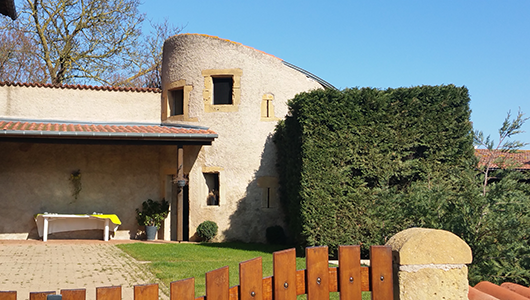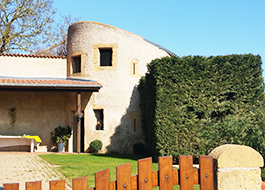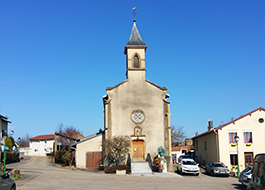Coin-lès-Cuvry
Durée visite : 30 minutes
Moyen : Pédestre
Coin-lès-Cuvry est un village du Pays Messin en l’Isle, de l’ancienne province des Trois-Évêchés. La seigneurie relevait de la famille de Gournay aux XVe siècle et XVIe siècle, puis de la famille Le Goullon au XVIIe siècle. Comme les autres communes de l’actuel département de la Moselle, Coin-lès-Cuvry est annexée à l’Empire allemand après la guerre franco-allemande de 1870. Coin-lès-Cuvry, rebaptisée Coin bei Cuvry, restera allemande jusqu’en 1918. Les habitants de la commune accueillent avec joie la fin des hostilités. Le village n’eut pas à souffrir de dégâts à cette époque. Coin-lès-Cuvry est de nouveau annexée par l’Allemagne, de 1940 à 1944. Il est rebaptisé Kuberneck. En 1940-1941, de nombreux habitants sont expulsés. Au cours de la bataille de Metz, les combats n’épargnent pas la commune. Malgré la combativité de la 462e Volks-Grenadier-Division, Coin-lès-Cuvry est libérée par la 5e Division d’infanterie de l’armée Patton, le 21 novembre 1944, à la fin de la bataille de Metz.
Coin-lès-Cuvry is a village in the Pays Messin en l’Isle, in the former province of Trois-Évêchés. The seigneury came under the de Gournay family in the 15th and 16th centuries, then the Le Goullon family in the 17th century. Like the other communes of the current Moselle department, Coin-lès-Cuvry was annexed to the German Empire after the Franco-German war of 1870. Coin-lès-Cuvry, renamed Coin bei Cuvry, will remain German until 1918. The inhabitants of the town welcome the end of hostilities with joy. The village did not have to suffer any damage at this time. Coin-lès-Cuvry is again annexed by Germany, from 1940 to 1944. It is renamed Kuberneck. In 1940-1941, many inhabitants were evicted. During the Battle of Metz, the fighting did not spare the town. Despite the combativeness of the 462nd Volks-Grenadier-Division, Coin-lès-Cuvry was liberated by the 5th Infantry Division of the Patton army on November 21, 1944, at the end of the Battle of Metz.
Coin-lès-Cuvry ist ein Dorf im Pays Messin en l’Isle in der ehemaligen Provinz Trois-Évêchés. Das Seigneury kam im 15. und 16. Jahrhundert unter die Familie de Gournay, dann im 17. Jahrhundert unter die Familie Le Goullon. Wie die anderen Gemeinden der heutigen Moselabteilung wurde Coin-lès-Cuvry nach dem Deutsch-Französischen Krieg von 1870 dem Deutschen Reich angegliedert. Coin-lès-Cuvry, umbenannt in Coin bei Cuvry, bleibt bis dahin deutsch 1918. Die Einwohner der Stadt begrüßen das Ende der Feindseligkeiten mit Freude. Das Dorf musste zu diesem Zeitpunkt keinen Schaden erleiden. Coin-lès-Cuvry wird von 1940 bis 1944 erneut von Deutschland annektiert. Es wird in Kuberneck umbenannt. In den Jahren 1940-1941 wurden viele Einwohner vertrieben. Während der Schlacht von Metz haben die Kämpfe die Stadt nicht verschont. Trotz der Kampfbereitschaft der 462. Volks-Grenadier-Division wurde Coin-lès-Cuvry am 21. November 1944 am Ende der Schlacht von Metz von der 5. Infanteriedivision der Patton-Armee befreit.

Mi-parti d’or à la tour de sable et d’azur trois fasces ondées d’argent, au chef abaissé d’or surmonté de trois étoiles du même.
A dextre, armes de la partie du Pays messin appelée l’Isle, de laquelle dépendait Coin; à senestre, armes de la famille Le Goullon, qui possédait la seigneurie au XVIIe siècle.
Half-party Or to the tower Sable and Azure three wavy fess Argent, a lowered chief Or surmounted by three stars of the same.
To the right, arms of the part of the Pays Metz called Isle, on which Coin depended; sinister, coat of arms of the Le Goullon family, which owned the seigneury in the 17th century.
Halbpartei Oder zum Turm Sable und Azure drei wellige Fess Argent, ein gesenkter Häuptling Oder überragt von drei Sternen desselben.
Rechts die Arme des Teils des Pays Metz namens Isle, von dem Coin abhing; unheimliches Wappen der Familie Le Goullon, der im 17. Jahrhundert das Seigneury gehörte.

Lés keulots de Coin = les bouts de chandelle de Coin.
Avant la culture des plantes oléagineuses (navette et colza), la chandelle de suif semble avoir prévalu en Lorraine jusqu’au début du 19e siècle. Elle avait — comme notre bougie de stéarine — la forme d’un petit cylindre de suif dont une mèche en coton filé occupait l’axe. Dans nos campagnes, les fileuses étaient autrefois tenues d’apporter chacune, à tour de rôle, la chandelle qui devait servir à l’éclairage de la crègne, c’est-à-dire de la réunion des crègneresses ou femmes qui passaient ensemble la veillée en filant. On plaçait alors la chandelle sur un bèyeboc, une colonne de bois dont le pied était fait d’une planche clouée dessous. Le long du bèyeboc pendait une ficelle au bout de laquelle était attachée une pincette métallique, la mouchette pour nettoyer la mèche ou étouffer la flamme du bout de la chandelle. Quant au sens à donner à ce curieux qualificatif des gens de Coin, les avis sont partagés. Certains l’attribuent à l’habitude des anciennes générations de faire par nécessité « une économie de bouts de chandelle », autrement dit, une épargne excessive jusque dans les moindres choses. — Selon d’autres, ce terme, employé au figuré, constitue une insulte à l’égard des habitants d’autrefois de ce coquet village. En effet, on les comparait à de petits bouts de chandelle, noirs de suie.
Réf. de Westphalen, Petit Dictionnaire, p. 677 – Zéliqzon, Dictionnaire, p. 63
Lés keulots de Coin = the ends of candle of Coin.
Before the cultivation of oilseed plants (rape and rapeseed), the tallow candle seems to have prevailed in Lorraine until the beginning of the 19th century. It had – like our stearin candle – the shape of a small cylinder of tallow with a spun cotton wick occupying the axis. In our countryside, the spinners were once required to bring each, in turn, the candle that was to be used to light the crègne, that is to say the meeting of the crègneresses or women who spent the night together. vigil by spinning. The candle was then placed on a beyeboc, a wooden column whose foot was made of a plank nailed below. Along the beyeboc hung a string at the end of which was attached a metal tweezer, the mouchette to clean the wick or to smother the flame at the end of the candle. As for the meaning to be given to this curious description of the people of Coin, opinions are divided. Some attribute it to the habit of the older generations of making out of necessity « a saving of candles », in other words, excessive savings even in the smallest things. – According to others, this term, used figuratively, constitutes an insult to the former inhabitants of this charming village. In fact, they were compared to small pieces of candle, black with soot.
Ref. de Westphalen, Small Dictionary, p. 677 – Zéliqzon, Dictionary, p. 63
Lés keulots de Coin = die Enden der Kerze der Münze.
Vor dem Anbau von Ölsaaten (Raps und Raps) scheint sich die Talgkerze in Lothringen bis zum Beginn des 19. Jahrhunderts durchgesetzt zu haben. Es hatte – wie unsere Stearinkerze – die Form eines kleinen Talgzylinders mit einem gesponnenen Baumwolldocht, der die Achse einnahm. Auf unserem Land mussten die Spinner einmal jeweils die Kerze mitbringen, mit der die Crègne angezündet werden sollte, dh das Treffen der Crègneressen oder Frauen, die die Nacht zusammen verbracht hatten. Mahnwache durch Drehen. Die Kerze wurde dann auf einen Bèyeboc gestellt, eine Holzsäule, deren Fuß aus einer darunter genagelten Planke bestand. Entlang des Beyeboc hing eine Schnur, an deren Ende eine Metallpinzette angebracht war, die Mouchette, um den Docht zu reinigen oder die Flamme mit dem Ende der Kerze zu ersticken. Was die Bedeutung dieser merkwürdigen Beschreibung der Menschen in Coin betrifft, so sind die Meinungen geteilt. Einige führen es auf die Gewohnheit älterer Generationen zurück, aus der Not heraus « Kerzen zu sparen », mit anderen Worten, übermäßige Einsparungen selbst bei kleinsten Dingen. – Anderen zufolge ist dieser Begriff im übertragenen Sinne eine Beleidigung für die ehemaligen Bewohner dieses charmanten Dorfes. Tatsächlich wurden sie mit kleinen Kerzenstücken verglichen, die schwarz von Ruß waren.
Ref. de Westphalen, Kleines Wörterbuch, p. 677 – Zéliqzon, Dictionary, p. 63

Les habitants et les habitantes de Coin-lès-Cuvry s’appellent les Cotocunerois et les Cotocuneroises.
The inhabitants of Coin-lès-Cuvry are called Cotocunerois and Cotocuneroises.
Die Einwohner von Coin-lès-Cuvry heißen Cotocunerois und Cotocuneroises.
Les points de visites
.
Ce reste de château était appelé la maison Forte de Prayelle. Au XVe et XVIe siècle la maison forte appartient à la famille Gournay. Au XVIIe siècle, elle passa aux mains des Le Goullon. Benoit Le Goullon possédait en 1681 un quart de la seigneurie dont dépendait la maison forte. Celle-ci entourée de fossés, de hautes murailles et de quatre tours, était bâtie au milieu d’une cour. Une des tours servait de colombier, de grange, d’écuries, de bergerie. Au XVIIIe siècle la seigneurie devint la propriété des Willemin. Aujourd’hui cette maison forte est utilisée en tant que maison d’habitation.
This remains of the castle was called the Forte de Prayelle house. In the 15th and 16th centuries the fortified house belonged to the Gournay family. In the 17th century, it passed into the hands of Le Goullon. Benoit Le Goullon owned in 1681 a quarter of the seigneury on which the stronghold depended. This surrounded by ditches, high walls and four towers, was built in the middle of a courtyard. One of the towers served as a dovecote, barn, stables, sheepfold. In the 18th century the seigneury became the property of the Willemin family. Today this fortified house is used as a dwelling house.
Diese Überreste der Burg wurden als Forte de Prayelle-Haus bezeichnet. Im 15. und 16. Jahrhundert gehörte das befestigte Haus der Familie Gournay. Im 17. Jahrhundert ging es in die Hände von Le Goullon über. Benoit Le Goullon besaß 1681 ein Viertel des Seigneury, von dem die Festung abhing. Diese von Gräben, hohen Mauern und vier Türmen umgebene wurde mitten in einem Innenhof errichtet. Einer der Türme diente als Taubenschlag, Scheune, Stall, Schafstall. Im 18. Jahrhundert ging das Seigneury in den Besitz der Familie Willemin über. Heute wird dieses befestigte Haus als Wohnhaus genutzt.
.
.
Cette chapelle porte le nom de Saint Barthélémy. Elle fait référence à la statuette de ce nom qui se situe dans une niche, au dessus de la porte d’entrée. Cette chapelle fut construite au XVIe siècle. Cette datation a été possible grâce à une pierre datée de 1500. L’architecture est gothique. Elle présente une nef possédant un vaisseau voûté. Celui-ci comporte deux travées. Il n’y a qu’une seule cloche. Celle-ci porte cette inscription : « En l’an 1736, Antoine BALTHAZART, Le Goullon, Chevalier, lieutenant Colonel du Régiment de Languedoc, Seigneur de Coin, Dame Marthe de la Mont, veuve de Monsieur Paul Le Goullon, Escuyer, ancien major du Régiment de la Reine, Cavalerie, vivant Seigneur de Coin et autre lieu. » Le clocher fut détruit pendant la seconde guerre mondiale. Il est reconstruit en octobre 1953. Il fut doté d’un coq de métal.
This chapel bears the name of Saint Barthélémy. It refers to the statuette of this name which is located in a niche, above the front door. This chapel was built in the 16th century. This dating was possible thanks to a stone dating from 1500. The architecture is Gothic. It has a nave with a vaulted vessel. This has two bays. There is only one bell. This one bears this inscription: « In the year 1736, Antoine BALTHAZART, Le Goullon, Chevalier, lieutenant colonel of the Languedoc regiment, Lord of Coin, Dame Marthe de la Mont, widow of Mr. Paul Le Goullon, Escuyer, former major of the Queen’s Regiment, Cavalry, living Lord of Coin and other place. » The bell tower was destroyed during the Second World War. It was rebuilt in October 1953. It was equipped with a metal rooster.
Diese Kapelle trägt den Namen des Heiligen Barthélémy. Es bezieht sich auf die Statuette dieses Namens, die sich in einer Nische über der Eingangstür befindet. Diese Kapelle wurde im 16. Jahrhundert erbaut. Diese Datierung war dank eines Steins aus dem Jahr 1500 möglich. Die Architektur ist gotisch. Es hat ein Kirchenschiff mit einem gewölbten Schiff. Dies hat zwei Buchten. Es gibt nur eine Glocke. Dieser trägt diese Inschrift: « Im Jahr 1736 Antoine BALTHAZART, Le Goullon, Chevalier, Oberstleutnant des Languedoc-Regiments, Lord of Coin, Dame Marthe de la Mont, Witwe von Paul Le Goullon, Escuyer, ehemaliger Major des Regiments der Königin, Kavallerie, lebender Lord of Coin und anderer Ort. » Der Glockenturm wurde im Zweiten Weltkrieg zerstört. Es wurde im Oktober 1953 wieder aufgebaut. Es erhielt einen Metallhahn.







